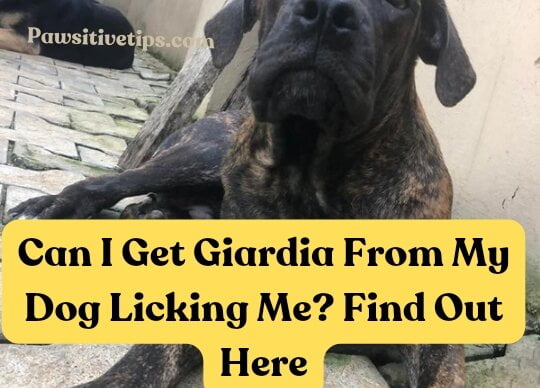Question: Can I Get Giardia From My Dog Licking Me?
 Heads up, guys! I have consistently maintained that I don’t like my dog licking me, and I know there are so many dog owners who don’t like it either. I had someone ask this question, “Can I Get Giardia From My Dog Licking Me?” the other day, and I am forced to provide an answer to this question and more related to the topic.
Heads up, guys! I have consistently maintained that I don’t like my dog licking me, and I know there are so many dog owners who don’t like it either. I had someone ask this question, “Can I Get Giardia From My Dog Licking Me?” the other day, and I am forced to provide an answer to this question and more related to the topic.
Please note that this information is for educational purposes only, and a healthcare professional should be consulted for accurate diagnosis and treatment.
Related articles:
- Can Dogs Get Mono? Understanding Mononucleosis in Dogs
- Can you get worms from your dog sleeping in your bed?
- Why Do Dogs Lick Their Paws Before Bed?
Now, let’s address these queries and provide you with the information you need to ensure the well-being of both you and your beloved dog.
Can I get Giardia from my dog licking me?
Giardia, a microscopic parasite, primarily resides in the intestines of infected dogs. While it is possible for dogs to pass on the parasite through various means, such as contaminated feces, it is unlikely that you will contract Giardia directly from your dog licking you. Here’s why:
- Ingestion of cysts: Giardia exists in two forms—cysts and trophozoites. The cysts responsible for transmission are hardy and can survive outside the host for extended periods. For transmission to occur, you would need to ingest the cysts, which are typically found in contaminated water, food, or environments.
- Oral-fecal route: Giardia is mainly spread through the fecal-oral route, meaning the cysts are passed in your dog’s feces and can contaminate surfaces, soil, or water sources. Direct transmission from licking occurs when the cysts are present in your dog’s mouth and come into contact with your mouth or an open wound.
Can Giardia be transmitted from dogs to humans?
Yes, it is possible for dogs to transmit Giardia to humans, but it is not very common. Just like we mentioned in the beginning, Giardia is a parasite that can live in the intestines of both animals and humans. It is spread through the feces of infected animals or humans. When an infected animal or human poops, the parasite can be released into the environment. If you come into contact with the parasite, it can enter your body through your mouth, nose, or eyes.
So, if your dog has Giardia and licks you, the parasite can be transmitted into your body through these routes:
- Direct contact: When your dog has Giardia and comes into contact with you, especially through licking your face, hands, or any open wounds, there is a slight risk of transmission.
- Contaminated objects: Giardia cysts can survive on objects such as toys, food bowls, or bedding. If you touch these contaminated items and subsequently touch your mouth or face, you could inadvertently ingest the cysts.
Is it easy for humans to get Giardia?
No, it is not easy for humans to get Giardia. The primary mode of transmission is through the ingestion of the parasite’s cysts, which are found in contaminated water, food, or surfaces. Although humans can contract Giardia, the risk of transmission is relatively low, and proper hygiene practices and a strong immune system can help minimize the chances of infection.
Should I quarantine my dog with Giardia?
Quarantining your dog with Giardia is not necessary. Instead, focus on proper management and treatment to prevent transmission to other animals or humans. So, here’s what to do:
- Consult with your veterinarian: It’s crucial to consult your veterinarian for guidance on your dog’s specific situation. They can assess the severity of the infection, the presence of symptoms, and any potential risk factors that may warrant quarantine.
- Prevent transmission to other animals: While the risk of transmission from dogs to humans is generally low, it is possible for other animals in close contact with the infected dog to become infected as well. If you have other dogs or pets in the household, it may be prudent to take precautions to prevent cross-contamination. This can include separating food and water bowls, cleaning and disinfecting shared spaces, and practicing good hygiene.
- Environmental hygiene: Pay attention to maintaining a clean living environment for your dog. Regularly clean and disinfect areas that may be contaminated with feces, such as bedding, toys, and living spaces. This helps minimize the risk of environmental contamination and potential reinfection.
- Proper hand hygiene: Always practice good hand hygiene after handling your dog, especially after cleaning up feces or coming into contact with potentially contaminated areas. Thoroughly washing your hands with soap and water helps reduce the risk of transmission to yourself or others.
How long does Giardia live in the yard?
Giardia cysts can survive in the environment for several weeks or months under favorable conditions. Factors that affect the survival of Giardia in the yard include temperature, moisture, and exposure to sunlight. While there is no fixed duration for how long Giardia can persist in the yard, it is important to take preventive measures to minimize the risk of transmission.
How do I disinfect my lawn from Giardia?
Disinfecting your lawn is a crucial step in reducing the risk of Giardia transmission. Follow these guidelines to effectively disinfect your lawn:
- Remove feces: Begin by promptly removing any dog feces from your lawn. Dispose of it properly, either in a sealed bag or by flushing it down the toilet.
- Diluted bleach solution: Mix a solution of 1 part bleach to 32 parts water. Apply this solution to the affected areas of your lawn where your dog was eliminated.
- Soak the area. Ensure that the bleach solution reaches the soil and thoroughly saturates the area. This helps kill the Giardia cysts present in the environment.
- Rinse with water: After allowing the bleach solution to sit for about 10–15 minutes, rinse the treated area with water to remove any residual bleach.
- Replanting and recovery: If necessary, consider reseeding or replanting the disinfected area of your lawn. This helps restore the health and appearance of the grass.
Why does my dog keep getting Giardia?
Recurrent Giardia infections in dogs can occur for various reasons. Here are some factors that may contribute to your dog repeatedly contracting Giardia:
- Reinfection from the environment: Dogs can become reinfected with Giardia if the environment is contaminated with cysts. If proper sanitation and disinfection measures are not implemented, the dog may ingest cysts again.
- Inadequate treatment: Failure to complete the full course of prescribed medication or insufficient dosage can lead to incomplete eradication of the parasite, allowing it to persist and cause reinfection.
- Exposure to infected animals: Interactions with other infected animals, such as through dog parks, boarding facilities, or communal water sources, can increase the likelihood of exposure and reinfection.
- Weakened immune system: Dogs with compromised immune systems may have reduced resistance to Giardia, making them more susceptible to repeated infections.
Consulting your veterinarian is crucial to determining the underlying cause of recurrent Giardia infections in your dog and developing an appropriate treatment and prevention plan.
What is the incubation period for Giardia?
The incubation period refers to the time between the initial infection and the onset of symptoms. In the case of Giardia, the incubation period can vary but typically ranges from 1 to 2 weeks. It’s important to note that not all infected individuals, both dogs and humans, show symptoms. Some may remain asymptomatic carriers, capable of shedding the parasite and potentially transmitting it to others without experiencing any signs of illness.
How long does it take to get rid of Giardia in dogs?
The duration of Giardia treatment in dogs depends on several factors, including the severity of the infection and the chosen treatment approach. Typically, treatment for Giardia in dogs lasts for about 5 to 7 days, although it can extend up to 2 weeks in more severe cases. Here are key points to consider:
- Veterinary guidance: Consult your veterinarian for a proper diagnosis and treatment plan tailored to your dog’s specific condition. They may recommend a combination of medication, dietary adjustments, and supportive care.
- Prescription medications: The most common treatment for Giardia in dogs involves the administration of specific medications, such as metronidazole or fenbendazole. Follow your veterinarian’s instructions regarding dosage, frequency, and duration of treatment.
- Follow-up fecal examinations: After completing the initial treatment course, your veterinarian may request follow-up fecal examinations to ensure the complete eradication of the parasite. This step is crucial to verifying the effectiveness of the treatment and preventing any potential relapses.
- Environmental management: While treating your dog, it’s essential to implement strict hygiene practices and environmental management to prevent reinfection. Clean up feces promptly, disinfect contaminated areas, and minimize your dog’s contact with potentially contaminated environments.
- Preventive measures: To reduce the risk of recurrence, consider preventive measures such as regular veterinary check-ups, maintaining good hygiene, providing clean drinking water, and avoiding exposure to potentially infected animals.
Remember that proper and consistent treatment, along with environmental hygiene, is key to successfully eliminating Giardia from your dog.
Can I walk my dog with Giardia?
Although it’s generally recommended to limit your dog’s interaction with other animals and environments while they have Giardia, walking your dog is not necessarily prohibited. Here are some guidelines to consider:
Seek guidance from your veterinarian to assess your dog’s specific condition and determine the most appropriate course of action. They will consider factors such as the severity of the infection, your dog’s overall health, and the risk of transmitting the parasite to other animals.
If you decide to walk your dog, take preventive measures to avoid potential transmission. Keep your dog on a leash and avoid close contact with other dogs or their feces. Prevent your dog from drinking from communal water sources, as they can be contaminated.
Maintain strict hygiene by washing your hands thoroughly after handling your dog, particularly before and after walks. This helps minimize the risk of transferring Giardia cysts to yourself or others.
It’s important to prioritize your dog’s recovery and complete the prescribed treatment before resuming regular activities, including walks. Follow your veterinarian’s advice regarding the appropriate timing for walks and increased physical activity.
What does Giardia do to humans?
In humans, a Giardia infection, known as giardiasis, can lead to gastrointestinal symptoms. Here’s what Giardia can do to humans:
- Gastrointestinal symptoms: The most common signs of giardiasis include diarrhea, which may be watery or greasy; abdominal pain or cramps; bloating; nausea; and vomiting. These symptoms can range from mild to severe and may last for weeks if left untreated.
- Dehydration: Prolonged diarrhea and vomiting can lead to dehydration, especially in vulnerable individuals such as young children and the elderly. It is essential to maintain hydration by consuming adequate fluids.
- Weight loss and malnutrition: Severe or prolonged giardiasis can interfere with nutrient absorption in the intestines, leading to weight loss and malnutrition, particularly in children.
- Fatigue and weakness: Giardia infection can cause fatigue and weakness, which can be attributed to the body’s immune response to the parasite and the impact of gastrointestinal symptoms.
- Temporary lactose intolerance: Some individuals with giardiasis may experience temporary lactose intolerance, where they have difficulty digesting lactose-containing foods, leading to bloating, gas, and diarrhea after consuming dairy products.
Can Giardia go away on its own in humans?
In some cases, giardiasis may resolve on its own without treatment, especially in individuals with strong immune systems. However, it’s important to note that relying on spontaneous resolution is not recommended due to the potential for complications and prolonged symptoms. Seeking medical attention and receiving appropriate treatment is crucial to ensuring complete eradication of the parasite and preventing further transmission.
How often should you bathe a dog with Giardia?
Dogs with Giardia should be bathed 1-2 times a week to remove cysts from the fur and prevent re-infection. You can use a regular pet shampoo or a shampoo specifically designed for treating Giardia. Be sure to rinse your dog thoroughly after bathing.
Can Giardia live on carpet?
Yes, Giardia can live on carpet. The parasite can survive for up to a month on moist, cool surfaces like carpet. If your pet has Giardia, it is important to clean and disinfect your carpets thoroughly to prevent the spread of the parasite.
Final thoughts
Before we wrap it up for today, although we mentioned that the risk of getting Giardia from your dog licking you is relatively low, don’t go ahead and kiss and allow your dog to lick your wound and nose carelessly because it is still possible to contract Giardia. Stay, and remember to visit your veterinarian if you suspect that your dog may have Giardia for proper treatment.


